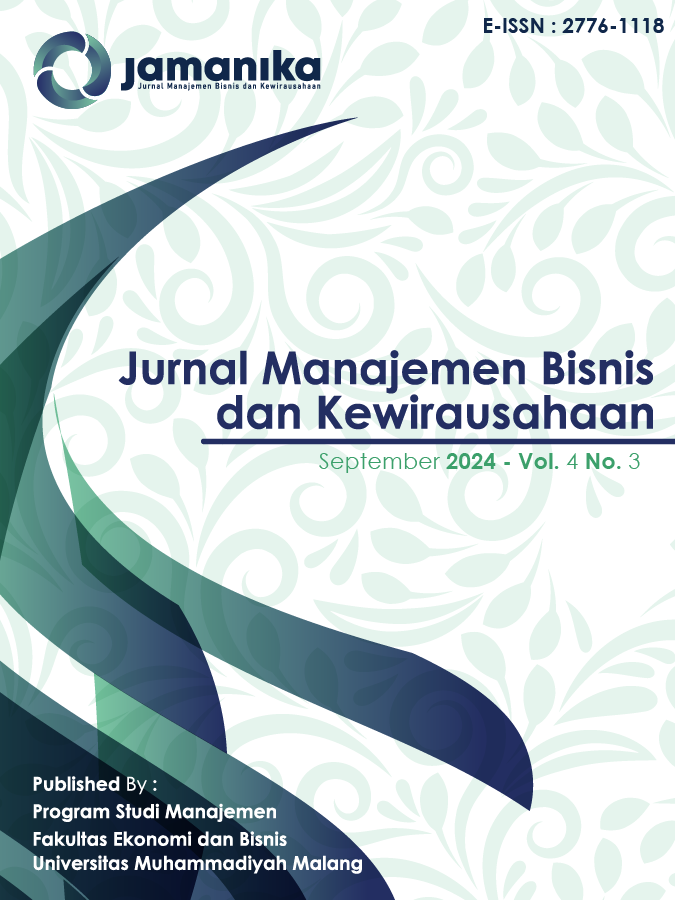Analysis of Trade Receivable Control of Wahyu Putra Distributors
DOI:
https://doi.org/10.22219/jamanika.v4i3.36128Keywords:
Granting Credit, Monitoring Receivables, Collection Of ReceivablesAbstract
This study aims to analyze the control of trade receivables at Wahyu Putra Distributors in 2019-2022. The analytical tools used are monitoring accounts receivable, assessing the Guttman scale, and identifying company policies and their implementation. This research shows that Wahyu Putra's distributors are less stringent in extending credit to customers. The credit standard implemented by the Wahyu Putra Distributor is only 2C, namely Character and Capacity and the credit requirements that are applied are too light. Monitoring of trade receivables such as accounts receivable turnover rate and the average day of collection of receivables between realization and the target is not in accordance with the results of the receivables aging schedule shows that many customers pay more than 30 days. The receivables collection policy that is applied is too mild and the company's policy in its implementation has been implemented according to operational standards. The conclusion of the study shows that the control of trade receivables in 2019-2022 at the Wahyu Putra Distributor is relatively ineffective, so it is necessary to make changes to the control of trade receivables in the company.
Downloads
References
Agustin, A. (2019). Analisis Pengendalian Piutang Terhadap Penagihan Piutang Arus Kas Pt.Cowell Development Tbk. Jurnal Bina Akuntansi, 6(2), 42–65. https://doi.org/10.52859/jba.v6i2.61
Brigham, E. F., & Houston, J. F. (2011). Dasar-dasar Manajemen Keuangan (Edisi 11). Salemba Empat.
Erlinda, G., & Dian, Nirmala Dewi, 2017. (2017). Analisis Piutang Dagang pada PT Cahaya Lestari Teguh Makmur (CLTM). Makalah Ilmiah Mahasiswa.
Hanafi, M. M. (2016). Manajemen Keuangan (Ed.2). BPFE.
Jusup, A. . H. (2011). Dasar-dasar Akuntansi Jilid 2 (Ed. 7). Bagian Penerbitan Sekolah Tinggi Ilmu Ekonomi YKPN.
Kasmir. (2015). Pengantar Manajemen Keuangan (Ed.1). Kencana.
Komardi, D., & Salim, W. (2017). Analisis Pengendalian Intern Piutang Dagang Pada PT Seriyus Hutama. 78, 110–126.
Mamduh, & Hanafi, M. (2015). Manajemen Keuangan (Ed 1). BPFE-YOGYAKARTA.
Mandasari, L., Rahmadhani, E., & Wahyuni, S. (2020). Efektivitas Perkuliahan Daring Pada Mata Kuliah Analisis Kompleks Selama Pandemi Covid 19. Jurnal As-Salam, 4(2), 269–283. https://doi.org/10.37249/as-salam.v4i2.205
Octaviany, F., Kustari, & Anasari, N. (2020). Analisis Tingkat Perputaran Piutang Pada Pt . Anugrah Textile Di Jakarta. Jurnal Lentera Akuntansi, 5(1), 1–8.
Purwaji, A., Wibowo, & Sri Lastanti, H. (2016). Pengantar Akuntansi 2. Salemba Empat.
Puspasari, A., Suhendra, A. D., & Kusnaeni, E. (2019). Pengendalian Internal Piutang Pada Pt.Saurindotex Mandiri Bekasi. Jurnal Ilmiah Manajemen, Ekonomi, & Akuntansi (MEA), 3(1), 29–43. https://doi.org/10.31955/mea.vol3.iss1.pp29-43
Riyanto, B. (2015). Dasar-dasar Pembelanjaan Perusahaan (Ed.2). Yayasan Penerbit Gadjah Mada.
Syamsuddin, L. (2013). Manajemen Keuangan Perusahaan (Edisi Terb). Rajawali Pers.
Utari, D., Purwanti, A., & Prawironegoro, D. (2014). Manajemen Keuangan (Edisi Revi). Mitra Wacana Media.
Yunus, & Wijaya, R. S. (2021). Analisis Efektivitas Pengelolaan dan Sistem Pengendalian Piutang Pada PT. Gunung Naga Distribusi. Jurnal Ekonomi Dan Bisnis Dharma Andalas, 23(2), 397–406.
Downloads
Published
Issue
Section
License
Copyright (c) 2024 Fatimataz Zahro, Warsono, Erna Retna Rahadjeng

This work is licensed under a Creative Commons Attribution-ShareAlike 4.0 International License.







